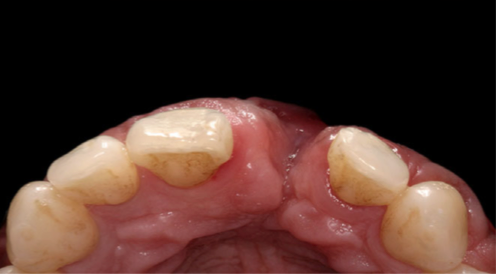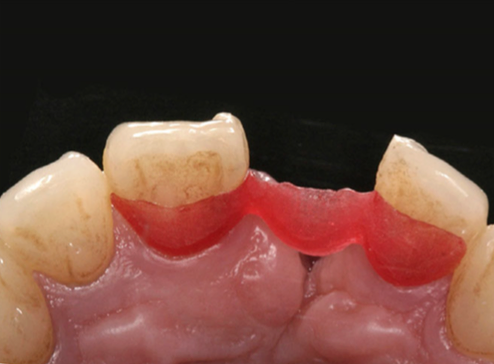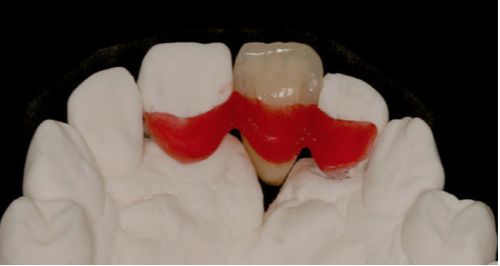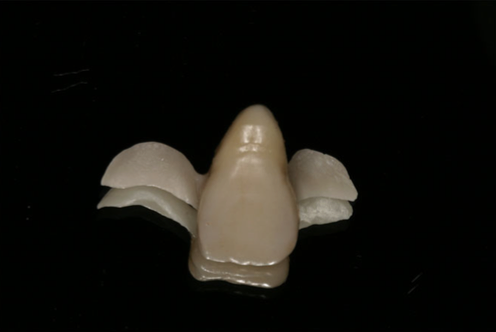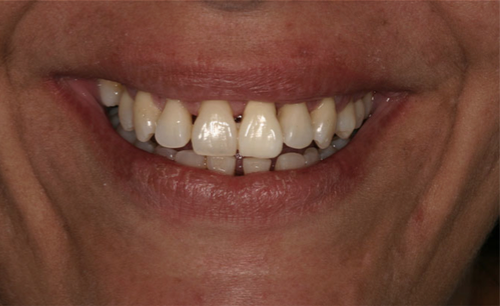Case Presentation
A 35-year-old woman presents to the office due to a spontaneous avulsion of her upper left central incisor. Her chief concern is to replace the missing tooth.
- Medical history shows that the patient is pregnant in the first trimester and she also has uncontrolled Diabetes Type II.
- Clinical exam shows generalized moderate periodontitis, and an alveolar defect in the area of the lost central incisor.
When replacing any missing tooth, we generally have three treatment options: implant placement, fixed prosthesis, and removable prosthesis. Due to the patient’s medical history, implant placement was not an option, as implant placement is contraindicated in a case of uncontrolled diabetes and pregnancy. A traditional fixed prosthesis such as a bridge was also not seen as viable option, due to financial constraints. Furthermore, the patient did not want to have a removable prosthesis as per her esthetic concerns.
Treatment Rendered
- Non-surgical periodontal treatment was first completed on all teeth.
- Full upper and lower arch impressions were taken for study model analysis.
- Analysis revealed sufficient occlusal clearance in order to fabricate a resin bonded fixed prosthesis with the patient’s own natural tooth.
- The avulsed tooth was first cleaned with an ultrasonic scaler and the root was sectioned to fit into the alveolar defect present in the area of the upper left central incisor.
- Retro-instrumentation and retro-filling of the avulsed tooth was now done.
- With now the modified natural tooth in hand, a build up on the study was done using pattern resin framework wax. It was decided that the framework would not extent beyond the first abutment teeth on either side in order to hide the presence of the framework in between the large embrasure spaces caused by the patient’s periodontal disease. Furthermore, this would eliminate possible interferences in mandibular excursion movements.
- Using the wax framework, a zirconia framework was milled.
- The tooth was bonded to the framework with resin cement (Multilink-Ivoclar Vivadent).
- The framework pontic area was cleaned with 9% buffered hydrofluoric acid for 20 seconds, washed and dried.
- A silane coupling agent was applied to the intaglio surface of the framework and allowed to evaporate for 3 minutes.
- The lingual surface of the tooth was primed.
- The adhesive cement was applied to the intaglio surface of the zirconia framework, excess cleaned off, and light cured for 1 minute.
- The framework was cemented to the abutment teeth using the same protocol above.
This case shows a method of replacing a missing tooth with a non-invasive and minimal cost treatment. It is important to consider that the abutment teeth were non-carious and the patient’s occlusion provided minimal contact with the retainer. In a case such as this, a resin bonded fixed retainer shows survival rate of 81.6% to 91.9% within 5 years, suggesting that this treatment can be a long-term or provisional option.
Using a zirconia framework provides the strength needed for function and the esthetic qualities that a metal framework doesn’t have. It’s been shown through randomized controlled trails that resin bonded fixed retainer with a zirconia framework has a 93.3% success rate in the first 5 years. With cleaning and applying silane to the zirconia framework, we can prevent the possibility of debonding.
This case was completed and presented by Dr. Wesley Vasquez DDS, MS (College of Dentistry, Federal Fluminense University, Niterói, Rio de Janeiro, Brazil).




